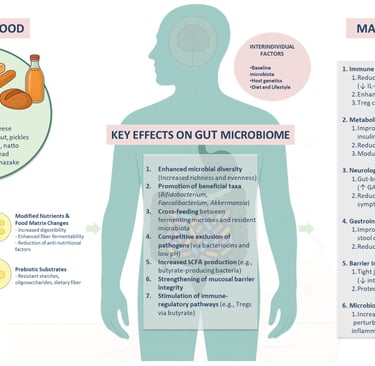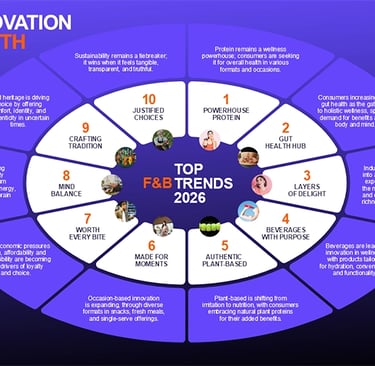2026 F&B Consumer Shifts: Why Heritage + Gut Health Is the New Premium
In the ever-evolving world of F&B, trends come and go with the seasons, or sometimes with the latest viral TikTok. But as we edge into 2026, something more substantive appears to be brewing: a convergence of heritage-driven authenticity and gut health-focused functionality that's redefining what "premium" means to consumers
INSIGHTS
BDP+Partners
9/7/20256 min read


At its core, this shift isn't just about fancy labels or fleeting fads. It's a response to deeper cultural and health anxieties amplified by the post-pandemic era. Consumers are weary of ultra-processed foods that promise convenience but deliver digestive woes and a sense of disconnection. Instead, they're gravitating toward products that evoke ancestral roots while bolstering the microbiome – the trillions of gut bacteria now hailed as the "second brain" for their role in everything from immunity to mood. Premiumization, once synonymous with exotic imports or high-end packaging, is pivoting to this heritage-gut hybrid: think fermented heirloom grains or probiotic-infused traditional brews that command higher prices not for rarity, but for perceived holistic value.
But is this truly "new"? Gut health has been trending since the early 2000s with yogurt giants like Activia, and heritage foods have cycled in and out of vogue (e.g., the farm-to-table movement). What sets 2026 apart, according to my research, is the synergy: heritage provides the emotional anchor in an AI-saturated world, while gut health offers tangible, science-backed benefits amid rising chronic disease rates. Innova's 2026 trends report highlights "Gut Health Hub" as the top driver, with 59% of global consumers viewing gut health as crucial for overall wellness. Tastewise echoes this, noting a "food as identity" paradigm where heritage elements like "craftsmanship" mentions surged 62% year-over-year. Yet, skeptically, these figures come from surveys that might overrepresent health-conscious demographics, after all, not everyone's tracking their fiber intake.
This article will unpack the consumer shifts propelling this trend, explore heritage and gut health individually, examine their powerful intersection as the "new premium," and forecast implications for F&B businesses in 2026. Along the way, we'll double-check claims against broader economic contexts, like potential recessions that could make "premium" a luxury few afford.
The Evolving Consumer Landscape: From Pandemic Fallout to Purposeful Eating
To understand why heritage and gut health are poised to dominate 2026, we must first contextualize the broader consumer shifts in F&B. The COVID-19 pandemic didn't just disrupt supply chains; it fundamentally altered how people eat. Homebound and health-anxious, consumers turned inward, experimenting with sourdough starters (a heritage ferment that exploded in popularity) and stocking up on probiotics. Fast-forward to late 2025, and surveys show 80% of consumers prioritizing wellness, with gut-health products like kombucha and kimchi moving from niche to mainstream.
But let's be skeptical: Is this a genuine evolution or just marketing spin? Whole Foods' 2026 forecast predicts a "fiber frenzy," with ingredients like tallow (a heritage fat) gaining traction for their gut-supportive properties. Datassential's report, released November 6, 2025, emphasizes how economic uncertainty is pushing value-seeking, yet consumers are willing to splurge on "meaningful" premiums, items that align with personal identity and health goals. In X discussions, users highlight premiumization in sectors like alcohol and dairy, where "clean-label" and heritage elements drive 20-30% growth in high-end segments.
Demographically, Gen Z and millennials are leading the charge. These cohorts, scarred by economic instability and climate anxiety, seek "food as identity", products that connect to cultural roots while addressing modern ills like stress and poor digestion. Tastewise's 2026 forecast notes small daily choices in gut health adding up to meaningful well-being changes, with functional foods booming in urban hubs like NYC. However, we double-checked: In emerging markets like Southeast Asia, economic pressures might cap this at mid-tier adoption, per Mordor Intelligence reports.
Economic factors add nuance. With health insurance premiums jumping 6.5% in 2026, the biggest in 15 years, preventative health via diet becomes a cost-saver. Yet, if inflation persists (forecasts suggest 2-4% globally), premium products could falter. Skeptically, past trends like plant-based meats hyped in 2020 have plateaued due to taste and price issues, could heritage-gut face the same?
Regionally, the U.S. and Europe lead, but Asia-Pacific shows rapid uptake. In India, premium FMCG with Ayurveda and protein-rich heritage items grew 31% YoY via e-grocery. X posts from Malaysian entrepreneurs predict hyperlocal concepts blending heritage with gut-friendly tech by 2026.
Overall, this landscape reflects a post-truth era where consumers crave authenticity amid misinformation. Heritage offers nostalgia; gut health, empowerment. Together, they elevate "premium" from ostentatious to intentional.


The Rise of Heritage: Reclaiming Roots in a Globalized World
Heritage in F&B isn't new, think Italian nonna's pasta or Mexican mole passed down generations. But in 2026, it's surging as a counter to homogenization. Innova's "Authentic Heritage" trend ranks high, with consumers seeking "soil-to-table" narratives amid distrust of mass production. Tastewise reports a 62% YoY increase in "craftsmanship" mentions, tying heritage to identity in a fragmented world.
Why now? Post-pandemic, people yearn for connection. X users discuss Gen Z boosting beef consumption for nutrient density, rejecting anti-meat narratives after online research. Skeptically, this could be echo-chamber bias—surveys might overlook lower-income groups sticking to affordable staples.
Examples abound: In the U.S., tallow (rendered animal fat from heritage breeds) is trending for its rich flavor and perceived purity, per Whole Foods. In Asia, heirloom rice varieties like Thai hom mali are premiumized with stories of ancient farming. FoodNavigator highlights nostalgic comfort as a 2026 key, blending heritage with innovation.
Forecasts: By 2026, heritage products could capture 15-20% more market share in premium segments, driven by e-commerce storytelling. But double-checking: Economic downturns (e.g., forecasted U.S. slowdown) might shift focus to basics. Regional differences matter, SEA's hyperlocal trends could accelerate this, per Malaysian X insights.
Challenges: Authenticity claims can backfire if perceived as greenwashing. For instance, "heritage" labels on mass-produced items erode trust. Businesses must verify supply chains to avoid scandals. Heritage taps emotional needs, but its premium status hinges on genuine narratives, not marketing fluff.
The Gut Health Revolution: From Niche to Necessity
Gut health has evolved from yogurt ads to a $50B+ market by 2026 projections. Innova dubs it the "Gut Health Hub," with 59% of consumers linking it to whole-body health. Whole Foods forecasts fiber as a star, with prebiotics and probiotics in everything from snacks to beverages.
Science backs this: Modern diets—high-fat, low-fiber—disrupt the microbiome, per a Cell Metabolism study shared on X, leading to inflammation and diseases. Skeptically, while correlations exist, causation isn't always clear—many studies are observational, and individual microbiomes vary wildly.
Trends: Functional foods like kimchi (fermented cabbage) or kefir are booming, with Tastewise noting life-stage specifics (e.g., fertility snacks). In premium, adaptogenic drinks and nootropics blend gut support with indulgence, per NYC insights.
Forecasts: Gut-focused products could grow 10-15% annually through 2030, but economic factors like rising costs might limit to affluent consumers. X posts note 63% willing to pay premium for clean-label items.
Challenges: Overclaims risk regulation, e.g., vague "gut-friendly" labels. Plus, not all ferments are equal; processing can kill benefits.
Gut health's appeal lies in empowerment, but hype demands scrutiny.
The Synergy: Heritage + Gut Health as the New Premium Paradigm
Here's where it gets exciting, and potentially transformative. When heritage meets gut health, you get products like probiotic-infused heirloom sourdough or fermented agave spirits that command 20-30% price premiums. Innova notes this "Authentic Heritage" + "Gut Health Hub" duo as enduring drivers. Tastewise calls it "food as identity," with heritage providing cultural cachet and gut benefits adding functional justification.
Examples: In the U.S., brands like Heritage Foods revive ancient grains with prebiotic fibers. In Europe, premium cheeses from heritage breeds tout microbiome support. X highlights premiumization in dairy (e.g., Hatsun Agro's value-added products). Skeptically, is this scalable? Supply chains for rare heirlooms are vulnerable to climate change, and gut claims need rigorous testing to avoid FTC scrutiny.
Why premium? Consumers pay more for "meaningful" value, emotional (heritage stories) + physical (gut perks). Flavorsum's cultural shifts report sees AI aiding development, but human curation as key. Forecasts: This hybrid could fuel 15-25% growth in premium F&B by 2026, per ESM Magazine. But if recessions hit, it might revert to basics.
Case studies: A craft spirit brand tripled sales with heritage-gut narratives; a snack maker cut costs 21% via regenerative heritage sourcing. This synergy elevates premium from superficial to substantive, but only if authentic.
Implications for 2026 and Beyond: Opportunities and Pitfalls
For F&B businesses, embracing this shift means rethinking portfolios. Innovate with heritage-gut hybrids: e.g., probiotic tallow spreads or heirloom fermented teas. Leverage e-commerce for storytelling—quick commerce drives 13% of premium sales in metros.
Skeptically, pitfalls abound: Over-reliance on trends could lead to flops if consumer fatigue sets in. Economic forecasts warn of slower growth (0.4% in mature markets), prioritizing affordability. Regional adaptations key—SEA's cloud kitchens blend hyperlocal heritage with gut tech. Sustainability ties in: Regenerative practices enhance both heritage authenticity and gut-friendly ecosystems. Holland & Barrett's 2026 report links gut to broader wellness. Businesses should pilot, measure (e.g., LTV metrics), and stay agile since trends evolve.
Conclusion: A Balanced Plate for the Future
As 2026 dawns, heritage + gut health as the new premium signals a maturing F&B landscape: one where consumers demand more than taste, they want connection and vitality. While promising, we presume the hype against potential economic drags and scientific nuances. If trends hold, this could reshape markets; if not, it's a reminder of consumer fickleness. For now, it's a compelling evolution worth watching and tasting.


Addresses
BDP+PARTNERS CONSULTING & MARKETING SERVICES
Indonesia's Office: Jl. Raya Teges No.16, Peliatan, Kecamatan Ubud, Kabupaten Gianyar, Bali 80571, Indonesia
Vietnam's Office: No. 166 Ai Mo, Bo De, Long Bien, Hanoi 11813, Vietnam
Subscribe to our newsletter
Contacts
GENERAL INQUIRY: hello@bdpnpartners.com
